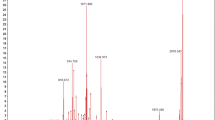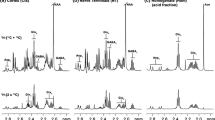Abstract
Rats were injected intracerebroventricularly (i.c.v.) or i.v. with [14C]homocarnosine (250 nmol). Distribution of the dipeptide in brain structures, transport from the brain to the blood, distribution in peripheral organs, and excretion in the urine were studied by measuring radioactivity in tissue, plasma, and urine samples by liquid scintillation counting 15–120 min after injection. After i.c.v. injection, [14C]homocarnosine was taken up into all parts of the brain investigated (highest uptake in structures close to the site of injection), it was transported to the blood, and radioactive substances were found in low concentration in muscle, spleen, and liver, in high concentration in the kidneys, and very high concentration in the urine. Investigations using high pressure liquid chromatography (HPLC) showed that no degradation took place in the brain, all radioactivity was found in the homocarnosine fraction. In the plasma 86% of the radioactivity was found in the GABA fraction presumed to be formed by cleavage of the peptide, while in the kidneys 35% and in the urine 40% was found in the GABA fraction. After i.v. injection of [14C]homocarnosine, no radioactivity was measured in hippocampus, striatum, cerebellum and cerebral cortex 15 min after injection, however, 60 min after injection a very low activity was detected in these structures (estimated intravascular radioactivity subtracted). A low activity was also measured in the spinal cord both 15 and 60 min after injection. When homocarnosine and GABA were separated on HPLC, all radioactivity in brain tissue was found in the GABA fraction, indicating either that [14C]homocarnosine did not cross the blood-brain barrier in amounts that could be measured with the method used, or that peptide entering the brain was rapidly transported back to the blood. [14C]Homocarnosine was not taken up either into crude synaptosomal preparations from hippocampus, striatum, cerebellum, cortex and spinal cord, or into slices prepared from the hippocampus and striatum. Transport from the brain to the kidneys and excretion in the urine seems to be a major route for disposal of this peptide in the rat.
Similar content being viewed by others
References
Abraham, D., Pisano, J. J., andUdenfriend, S. 1962. The distribution of homocarnosine in mammals. Arch. Biochem. 99:210–213.
Abraham, D., Pisano, J. J., andUdenfriend, S. 1964. Uptake of carnosine and homocarnosine by rat brain slices. Arch. Biochem. Biophys. 104:160–165.
Adibi, S. A. 1977. Clearance of dipeptides from plasma: role of kidney and intestine. Pages 256–280, in Ciba Foundation Symposium 50, Peptide Transport and Hydrolysis, Elsevier, Amsterdam.
Bohlen, P., Tell, G., Schechter, P. J., Koch-Weser, J., Agid, Y., Coquillat, G., Chazot, G., andFischer, C. 1980. Cerebrospinal fluid homocarnosine in Huntington's disease. Life Sci. 26:1009–1012.
Gjessing, L. R., Gjesdahl, P., andSjaastad, O. 1972. The free amino acids in human cerebrospinal fluid, J. Neurochem. 19:1807–1808.
Gjessing, L. R., andSjaastad, O. 1974. Homocarnosinosis: a new metabolic disorder associated with spasticity and mental retardation. Lancet, ii:1028.
Hayashi, T. 1966. Gamma-aminobutyric acid and its derivatives in mental health. Pages 160–170,in Martin, G. J., andKish, B. (eds), Enzymes in mental health, J. B. Lippincot, Philadelphia.
Hole, K., Bergslien, H., Jørgensen, H. A., Berge, O.-G., Reichelt, K. L., andTrygstad, O. E. 1979. A peptide-containing fraction in the urine of schizophrenic patients which stimulates opiate receptors and inhibits dopamine uptake. Neuroscience. 4:1883–1893.
Hole, K., Johnson, G. E., andBerge, O.-G. 1977. 5,7-Dihydroxytryptamine lesions of the ascending 5-hydroxytryptamine pathways: habituation, motor activity and agonistic behavior. Pharmacol. Biochem. Behav. 7:205–210.
Houghten, R. A., Swann, R. W., andLi, C. H. 1980. β-Endorphin: stability, clearance behavior, and entry into the central nervous system after intravenous injection of the tritiated peptide in rats and rabbits. Proc. Natl. Acad. Sci. 77:4588–4591.
Kastin, A. J., Olson, R. D., Schally, A. V., andCoy, D. H. 1979. CNS effects of peripherally administered brain peptides. Life Sci. 25:401–414.
Kish, S. J., Perry, T. L., andHansen, S. 1979. Regional distribution of homocarnosine, homocarnosine-carnosine synthetase and homocarnosinase in human brain. J. Neurochem. 32:1629–1636.
Lenney, J. F., George, R. P., Weiss, A. M., Kucera, C. M., Chan, P. W. H., andRinzler, G. S. 1982. Human serum carnosinase: characterization, distinction from cellular carnosinase, and activation by cadmium. Clin. Chim. Acta. 123:221–231.
Lenney, J. F., Kan, S.-C., Siu, K., andSugiyama, G. H. 1977. Homocarnosinase: a hog kidney dipeptidase with a broader specificity than carnosinase. Arch. Biochem. Biophys. 184:257–266.
Lunde, H., Sjaastad, O., andGjessing, L. 1982. Homocarnosinosis: hypercarnosinuria. J. Neurochem. 38:242–245.
Ng, R. H., Marshall, F. D., Henn, F. A., andSellstrom, A. 1977. Metabolism of carnosine and homocarnosine in subcellular fractions and neuronal and glial cell-enriched fractions of rabbit brain, J. Neurochem. 28:449–452.
Ohno, K., Pettigrew, K. D., andRapoport, S. J. 1978. Lower limits of cerebrovascular permeability to nonelectrolytes in the conscious rat. Am. J. Physiol. 235:H299-H307.
Oldendorf, W. H. 1971. Brain uptake of radiolabeled amino acids, amines, and hexoses after arterial injection. Am. J. Physiol. 221:1629–1639.
Passaro, E., Jr., Debas, H., Oldendorf, W., andYamada, T. 1982. Rapid appearance of intraventricularly administered neuropeptides in the peripheral circulation. Brain Res. 241:338–340.
Perry, T. L., Hansen, S., Berry, K., Mok, C., andLesk, D. 1971. Free amino acids and related compounds in biopsies of human brain. J. Neurochem. 18:521–528.
Perry, T. L., Hansen, S., andKloster, M. 1973. Huntington's chorea. Deficiency of γ-aminobutyric acid in brain. N. Eng. J. Med. 288:337–342.
Perry, T. L., Hansen, S., Stedman, D., andLove, D. Homocarnosine in human cerebrospinal fluid: an age-dependent phenomenon. J. Neurochem. 15:1203–1206.
Perry, T. L., Kish, S. J., Sjaastad, O., Gjessing, L. R., Nesbakken, R., Schrader, H., andLøken, A. C. 1979. Homocarnosinosis: increased content of homocarnosine and deficiency of homocarnosinase in brain. J. Neurochem. 32:1637–1640.
Pisano, J. J., Wilson, J. D., Cohen, L., Abraham, D., andUdenfriend, S. 1961. Isolation of γ-aminobutyrylhistidine (homocarnosine) from brain. J. Biol. Chem. 236:499–502.
Rapoport, S. I., Klee, W. A., Pettigrew, K. D., andOhno, K. 1980. Entry of opioid peptides into the central nervous system. Science. 207:84–86.
Sjaastad, O., Berstad, J., Gjesdahl, P., andGjessing, L. 1976. Homocarnosinosis. 2. A familial metabolic disorder associated with spastic paraplegia, progressive mental deficiency, and retinal pigmentation. Acta Neurol. Scand. 53:275–290.
Sjaastad, O., Gjessing, L., Berstad, J. R., andGjesdahl, P. 1977. Homocarnosinosis. 3. Spinal fluid amino acids in familial spastic paraplegia. Acta Neurol. Scand. 55:158–162.
Slater, P., andTurnbull, M. J. 1969. Hypothermia following intraventricular injection of homocarnosine in the rat. Life Sci. 8:441–447.
Takahashi, H. 1981. Studies on homocarnosine in cerebrospinal fluid in infancy and childhood. Part I. Homocarnosine level in cerebrospinal fluid of normal infants and children. Brain Dev. 3:255–261.
Takahashi, H. 1981. Studies on homocarnosine in cerebrospinal fluid in infancy and childhood. Part II. Homocarnosine levels in cerebrospinal fluid from children with epilepsy, febrile convulsion or meningitis. Brain Dev. 3:263–270.
Trygstad, O. E., Reichelt, K. L., Foss, I., Edminson, P. D., Sælid, G., Bremer, J., Hole, K., Ørbeck, H., Johansen, H. J., Bøler, J. B., Titlestad, K., andOpstad, P. K. 1980. Patterns of peptides and protein-associated peptide complexes in psychiatric disorders. Br. J. Psychiat. 136:59–72.
Turnbull, M. J., Slater, P., andBriggs, I. 1972. An investigation of the pharmacological properties of homocarnosine. Arch. Int. Pharmacodyn. 196:127–132.
Van Balgooy, J. N. A., andRoberts, E. 1975. Studies of metabolism of imidazole compounds in mouse brain. Biochem. Pharmacol. 24:1421–1425.
Van Sande, M., Mardens, Y., Adriaenssens, K., andLowenthal, A. 1970. The free amino acids in human cerebrospinal fluid. J. Neurochem. 17:125–135.
Author information
Authors and Affiliations
Rights and permissions
About this article
Cite this article
Ziesler, Ø., Hole, K., Haugan, I. et al. Transport and distribution of homocarnosine after intracerebroventricular and intravenous injection in the rat. Neurochem Res 9, 637–648 (1984). https://doi.org/10.1007/BF00964510
Accepted:
Issue Date:
DOI: https://doi.org/10.1007/BF00964510




